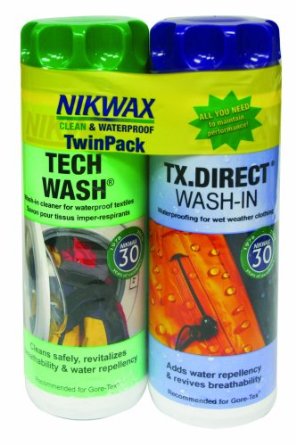Can a polyurethane-treated cotton coat be dyed?
Name: Sebastian
—ADVERTISEMENTS—
Refresh and restore DWR water-repellent finishes on outdoor gear

DWR finishes are incompatible with dyeing. DWR finishes should be applied only after dyeing is completed.
Country or region: Canada
Message: Hello, I have a winter coat that has faded unevenly, and would like to dye it back to a solid dark olive green. It's has a 100% cotton shell, with a polyurethane treatment on the fabric, which explains why it totally rejected the fibre-reactive dye I attempted to use on it. This coating does help block out the wind, but doesn't seem to be water-repellant (rain soaks in quite easily rather than beading up) - can it be dyed? I've seen some advice on your site stating that Lycra (elastic polyurethane) cannot be dyed, but in some other places I've seen those 2:1 pre-metallized acid dyes recommended for PU foam. Thank you for your time!
I think your coat almost certainly has a DWR (durable water resistant) coating on it, in addition to the polyurethane, but which is not currently working due to normal dirt accumulation from wear. The DWR coating, like all fabric finishes, is never referenced in the fiber contents label. I believe that DWR finishes are typically made of either silicone or fluorocarbons (the latter being related to Teflon).
You will never be able to remove the DWR finish enough to allow dyeing. The best course is to restore the DWR finish so that it functions well again, even though this will do nothing to solve the fading.
The way to restore the function of a DWR finish is to wash the coat thoroughly, preferably using a product such as Nikwax Tech Wash, then machine dry it for at least fifteen minutes at medium heat. Remove the coat from the dryer immediately after the cycle ends, to prevent creasing. Both the cleaning and the heat of the dryer are needed to restore a DWR finish. If the DWR finish is not sufficiently restored for function by washing and drying, you can apply another layer. Suitable products include Nikwax TX Direct Wash In Water Repellent and Nikwax TX Direct Spray On. (There are probably other brand names that are as good, but this is the brand name I've used myself. Try calling an REI store, or another store that specializes in camping and climbing gear, for advice on other brands.)
It's true that Lycra and other brands of spandex can be dyed (see my page, "How to Dye Spandex"), but it's generally impractical to do so. When spandex is blended with other fibers, it's almost always best, for home dyeing, to dye only the other fiber. The spandex portion of blends does not even show except when the fabric is stretched, and the conditions required to dye the spandex itself are better used before the spandex is incorporated into a garment, since the heat required (40°F or 60°C) may cause the spandex in the garment to lose its shape.
If your coat did not have a DWR finish, and if the polyurethane were actually on the outside of the fabric, then it might make sense to try dyeing it with 1:2 metal-complex acid dyes, probably in the same color as the entirely different dyes required to dye the cotton itself, but I think chances are very small that there's no DWR finish. I think that actually the polyurethane may not be a treatment on the fabric at all, but instead a membrane that is hidden inside the fabric of the outer shell. A DWR finish is applied to polyurethane-laminate fabric to keep the fabric from absorbing water and becoming heavy; the polyurethane membrane prevents water from penetrating the fabric all the way through, but wet fabric is disagreeable to wear even when no water is coming through it.
(Please help support this web site. Thank you.)
(Please help support this web site. Thank you.)
Posted: Sunday - February 12, 2012 at 10:06 AM
Follow this blog on twitter here.
Quick Links
- All About Dyes & Dyeing Top -
- Top of this blog -
- FAQ -
- The Dye Forum -
- How to Tie Dye - How to Batik -
- Books - Toys - Plants -
- Top of this blog -
- FAQ -
- The Dye Forum -
- How to Tie Dye - How to Batik -
- Books - Toys - Plants -
More in this category:
- -
Statistics
Total entries in this blog:
Total entries in this category:
Published On: Aug 29, 2012 02:49 PM
Total entries in this category:
Published On: Aug 29, 2012 02:49 PM